A delicious French Brioche Loaf which is soft and buttery. Follow this easy brioche recipe with step-by-step photos.
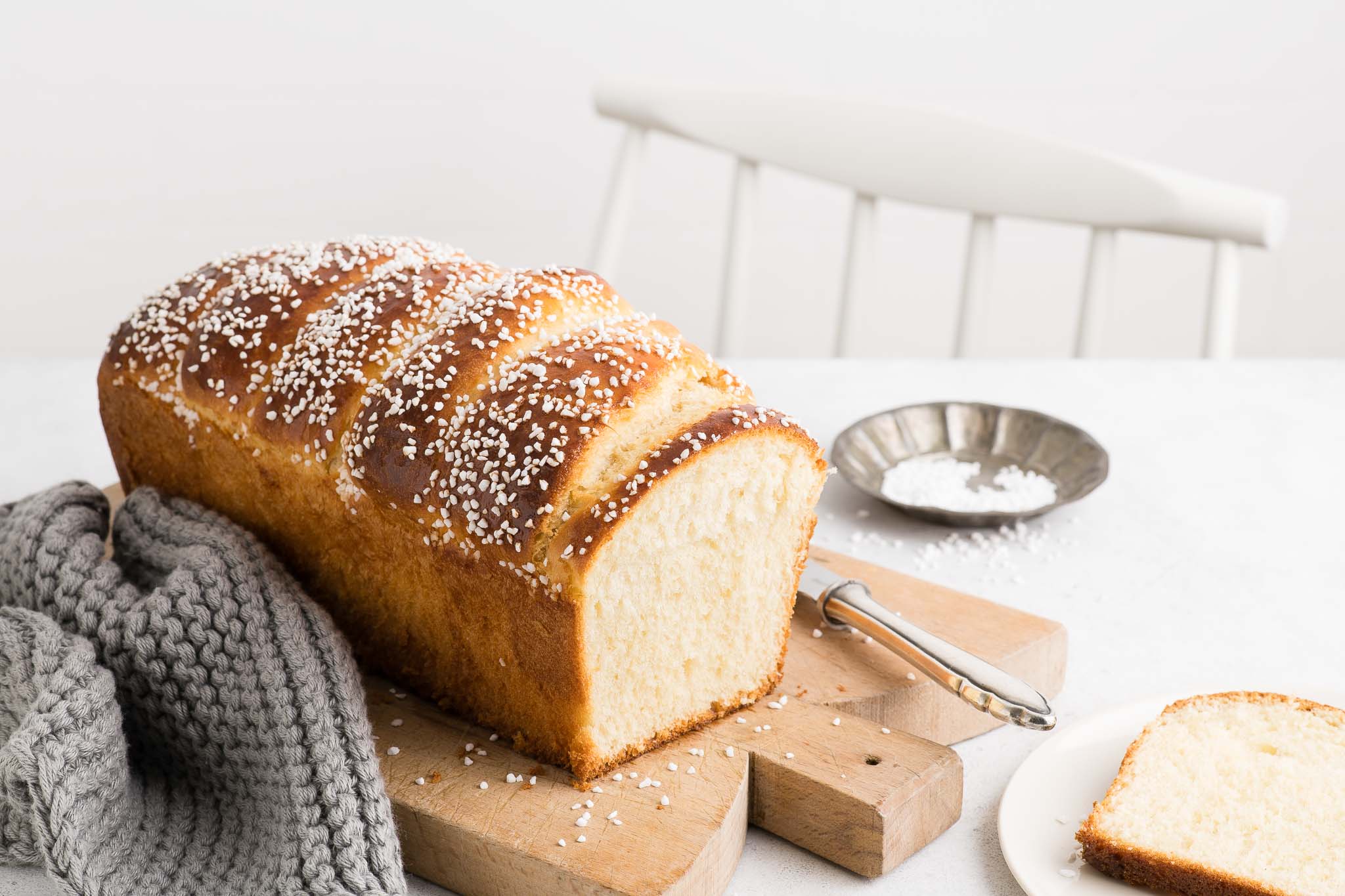
Homemade Brioche
Something I am really into at the moment is making homemade brioche. At this particular point in time, i.e. March 2020 during the outbreak of a certain virus, the majority of people seem to be searching the internet for a million and one ways to bake bread at home.
I love the bread from our local bakery too much to consider replacing it with a homemade version (yet), but I have been churning out so much brioche lately that, when this surreal situation is over, I may never actually buy brioche again for the simple fact that my homemade brioche tastes so much better!
Why This Recipe Works
- Follow this easy brioche recipe with step-by-step photos for the perfect results.
- Bake this brioche in a simple loaf pan – no need for any fancy cake pans.
- Any leftover brioche loaf is delicious lightly toasted for breakfast.
- This recipe doubles well so you can bake two loaves at the same time – simply freeze the second loaf for another time!
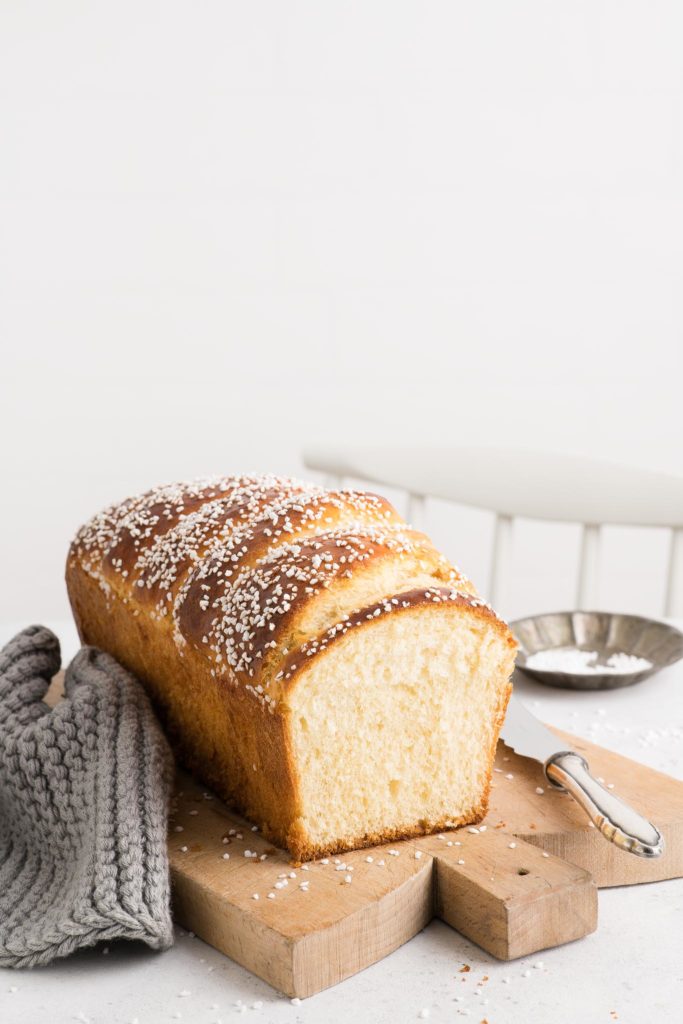
Brioche Loaf
The brioche my children love to eat is a Brioche à Tête, which is a small bun with a little head (the “tête”) attached on top. I like to make a bigger version of this at home, and you can find my recipe for Brioche à Tête here.
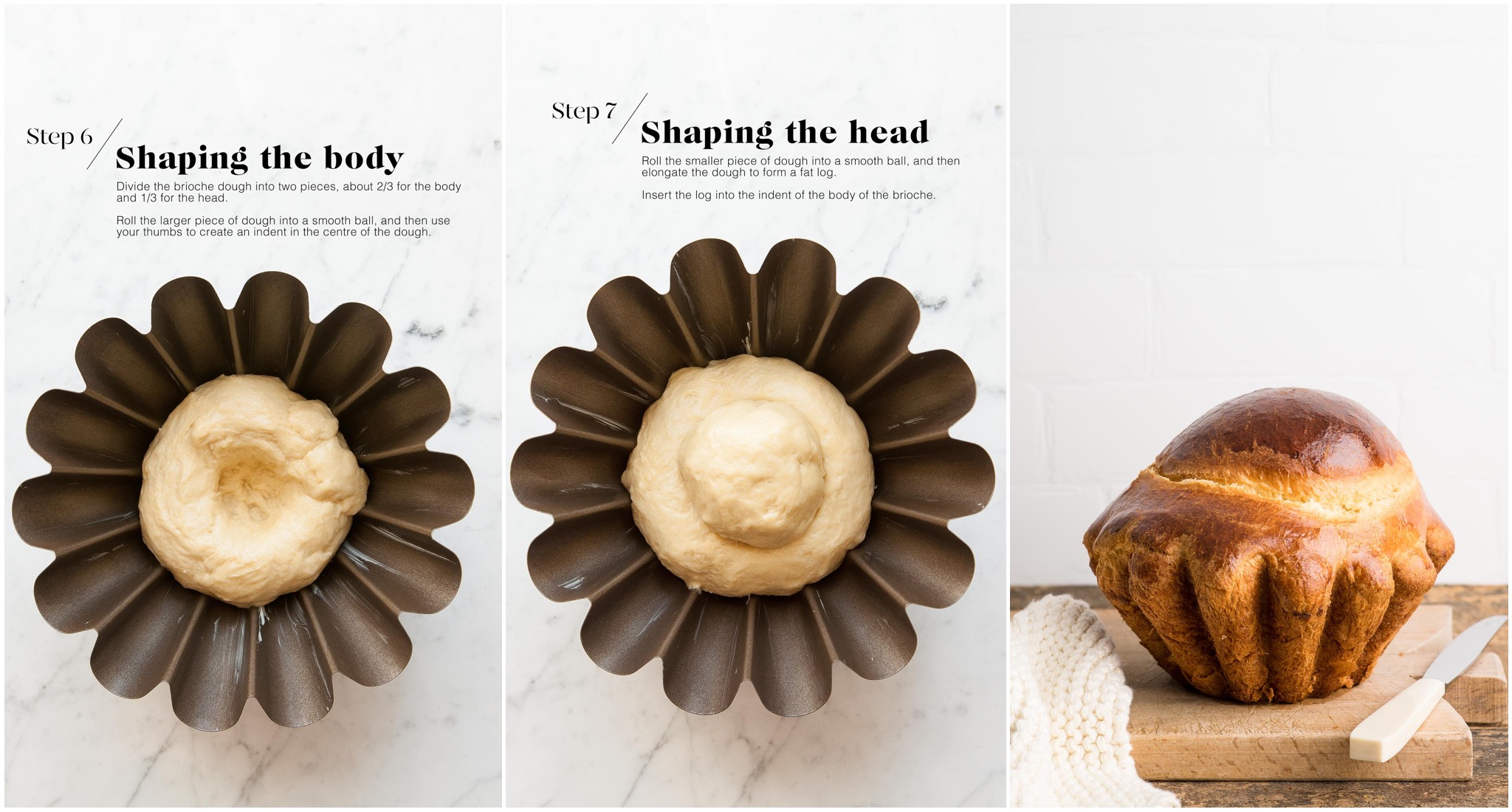
But brioche is also commonly baked as a loaf, and the advantage of a brioche loaf is that you can slice it thickly for the most fabulous toast at breakfast.
I also like to use slices of stale brioche loaf (if there is ever such a thing) for making a very decadent Brioche French Toast.
And in France, brioche loaf is often paired with homemade Chicken Liver Pâté for one of my favourite appetisers.
French Brioche Recipe
My recipe below for a French brioche loaf is essentially the same as for a Brioche à Tête, except the instructions for shaping the dough is different.
Making a brioche loaf is perhaps a little bit easier because you can use a simple loaf pan – there is no need to buy a special brioche pan.
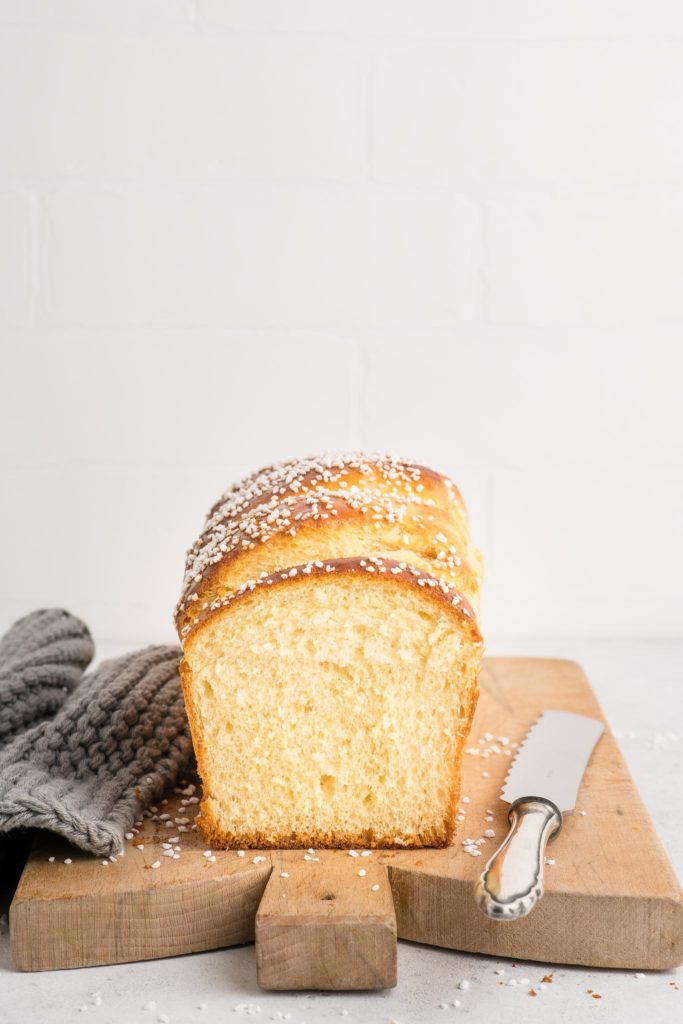
How to Make a Brioche Loaf
Step 1
Measure the flour, sugar, yeast and salt into the bowl of an electric stand mixer.
This recipe uses instant yeast, so you can add the yeast directly to the dry ingredients.
Step 2
In a small bowl, lightly whisk together the milk and eggs. The milk should be warmed to blood temperature, and the eggs should be at room temperature.
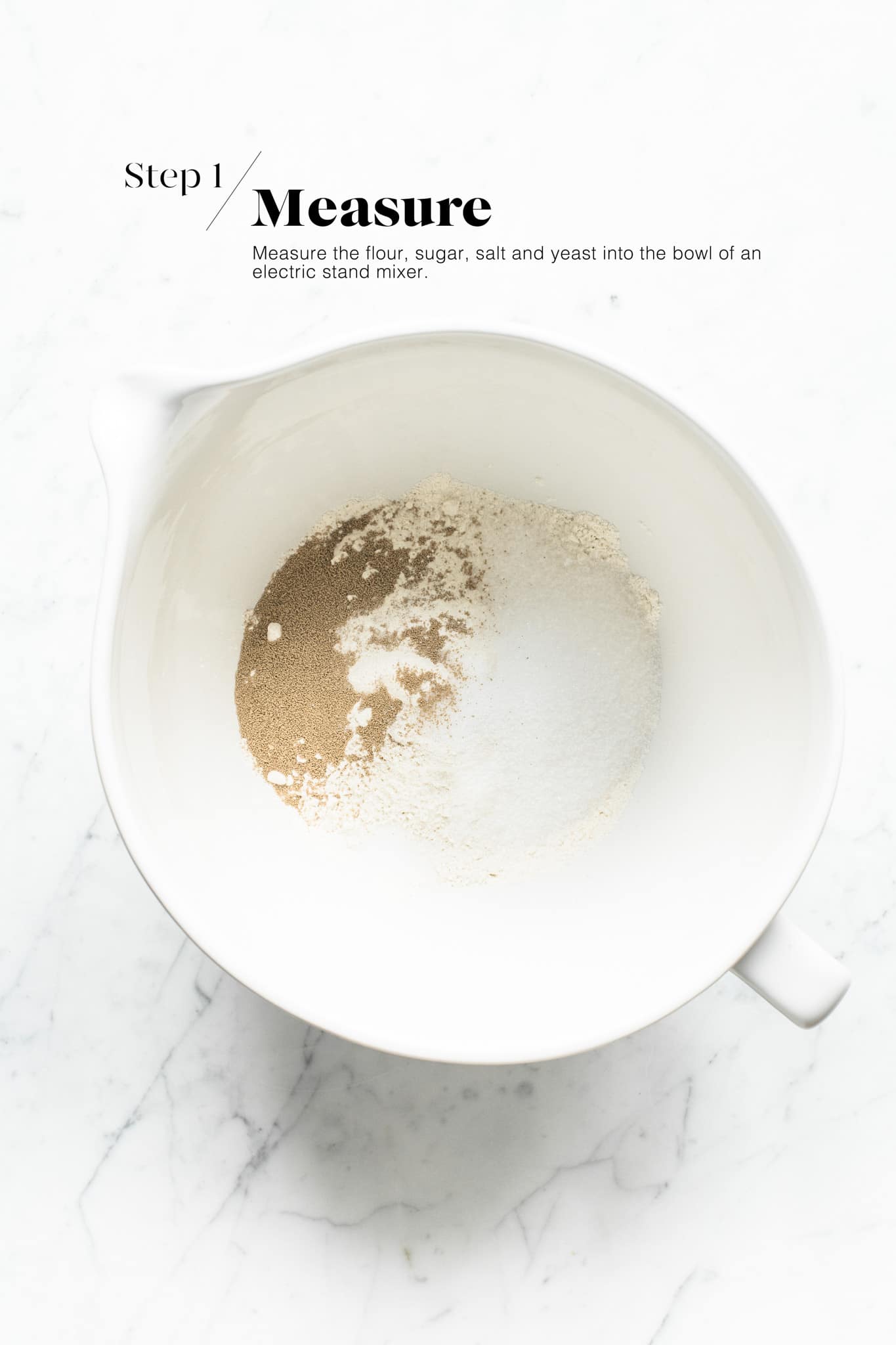
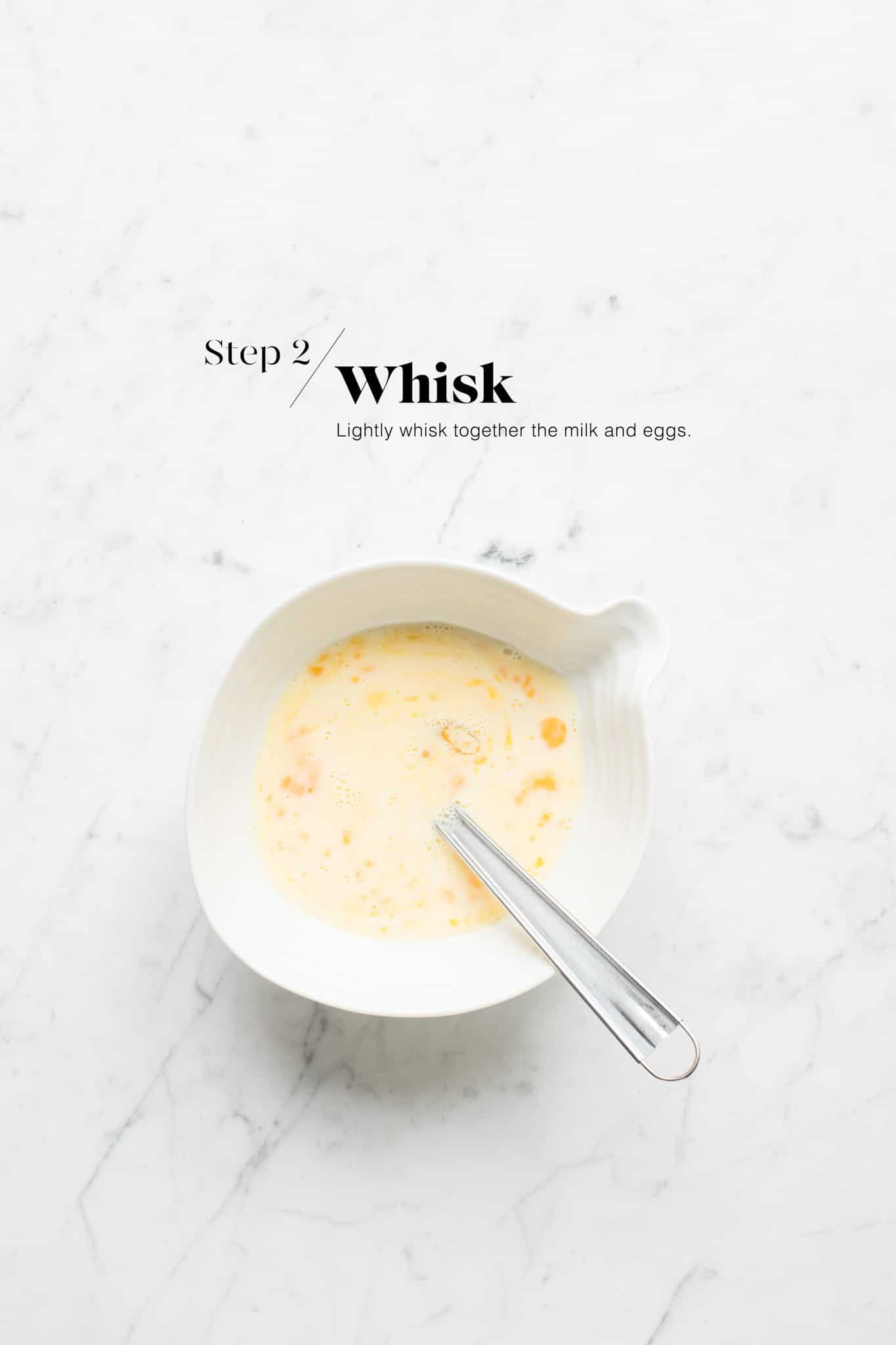
Step 3
Using the dough hook on the stand mixer, mix the liquid ingredients into the dry ingredients, and keep beating until everything comes together into a sticky dough.
You may need to scrape down the sides of the bowl once or twice.
Beat on medium speed for 5-10 minutes until you have a ball of sticky dough.
At this stage, the dough should be loosely forming around the bottom of the dough hook.
Step 4
Slowly incorporate the butter, one tablespoon at a time. Repeat until all of the butter has been used.
Beat again on medium-high speed for about 10 to 20 minutes, or until you have a very soft and sticky dough which comes away from the sides of the bowl.
I also recommend doing the windowpane test, which is to stretch a piece of dough from the dough hook, until it is thin enough that you can almost see through the “window” of dough, and without the dough breaking as you do this test.
Beating (or kneading) the dough for a sufficient amount of time will allow you to develop the gluten in the dough, and it is the gluten which will give the dough some elasticity, which in turn will result in a nice chewy texture.
If you don’t knead the dough long enough, the resulting brioche will have a texture more similar to a cake than bread.

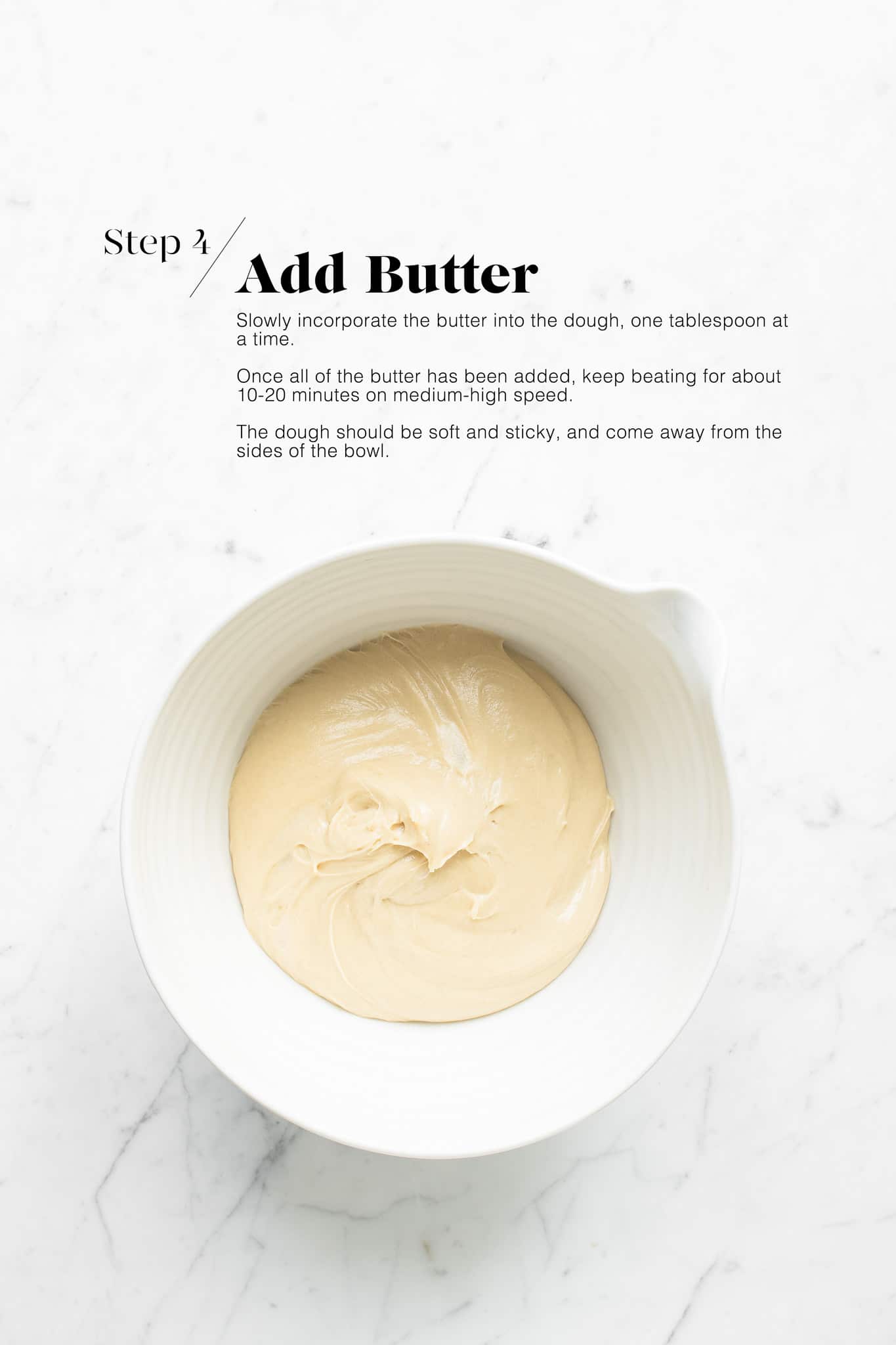
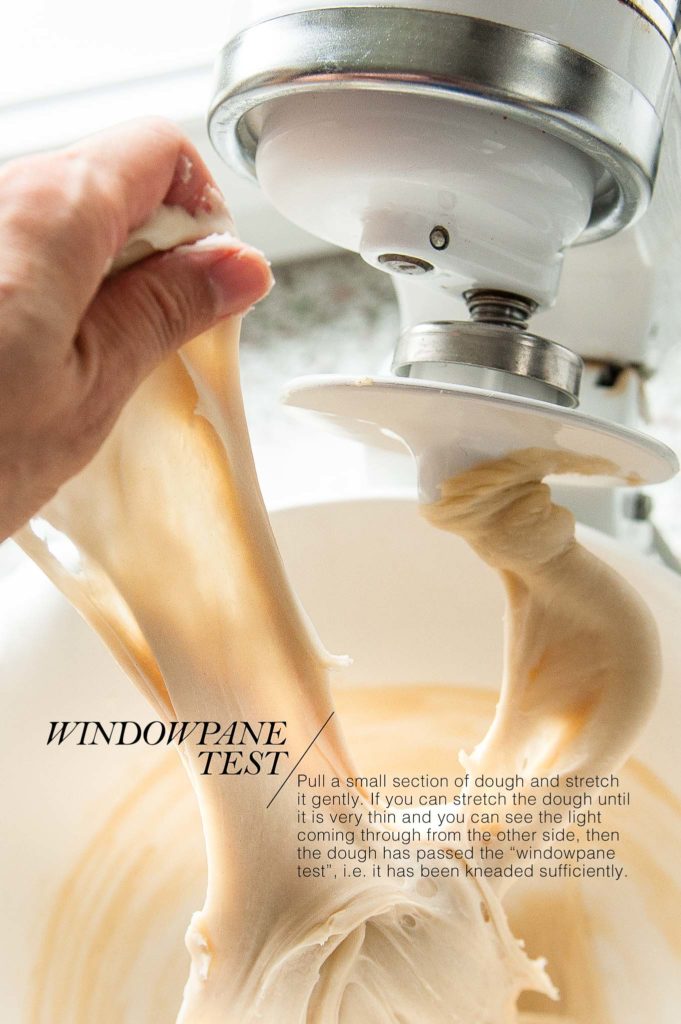
Step 5
Lighly oil a large bowl. You will need a bowl that is large enough for the dough to at least triple in size.
Use a dough scraper to remove the brioche dough to the bowl.
Place the bowl somewhere warm for the dough to prove for 1-2 hours, or until it has doubled in size.
Without touching the dough, cover the bowl with clingfilm, and place the bowl with the risen dough into the fridge to chill overnight.
The dough will rise some more overnight.
Step 6
Generously grease a loaf pan with butter, or use non-stick baking spray. I use a loaf pan which is 25 x 10.5 cm/10 x 4 inches.
Remove the bowl of dough from the fridge. Punch down the dough and knead it gently into a ball.
Weigh the ball of dough and divide this measurement by 6, so that you can portion the dough into six pieces equally. You can, of course, just eye-ball the measurement.
Roll each piece of dough into a smooth ball, and then gently elongate the balls of dough into a small fat log.
Arrange the six logs of dough into the loaf pan.
Place the loaf pan somewhere warm for the dough to rise and at least double in size. This should take about 2 hours.
I generally aim for the edges of the brioche dough to rise to about 1-2 cm (1 inch) below the rim of the pan. Once you bake the brioche, it will continue to rise a lot more.
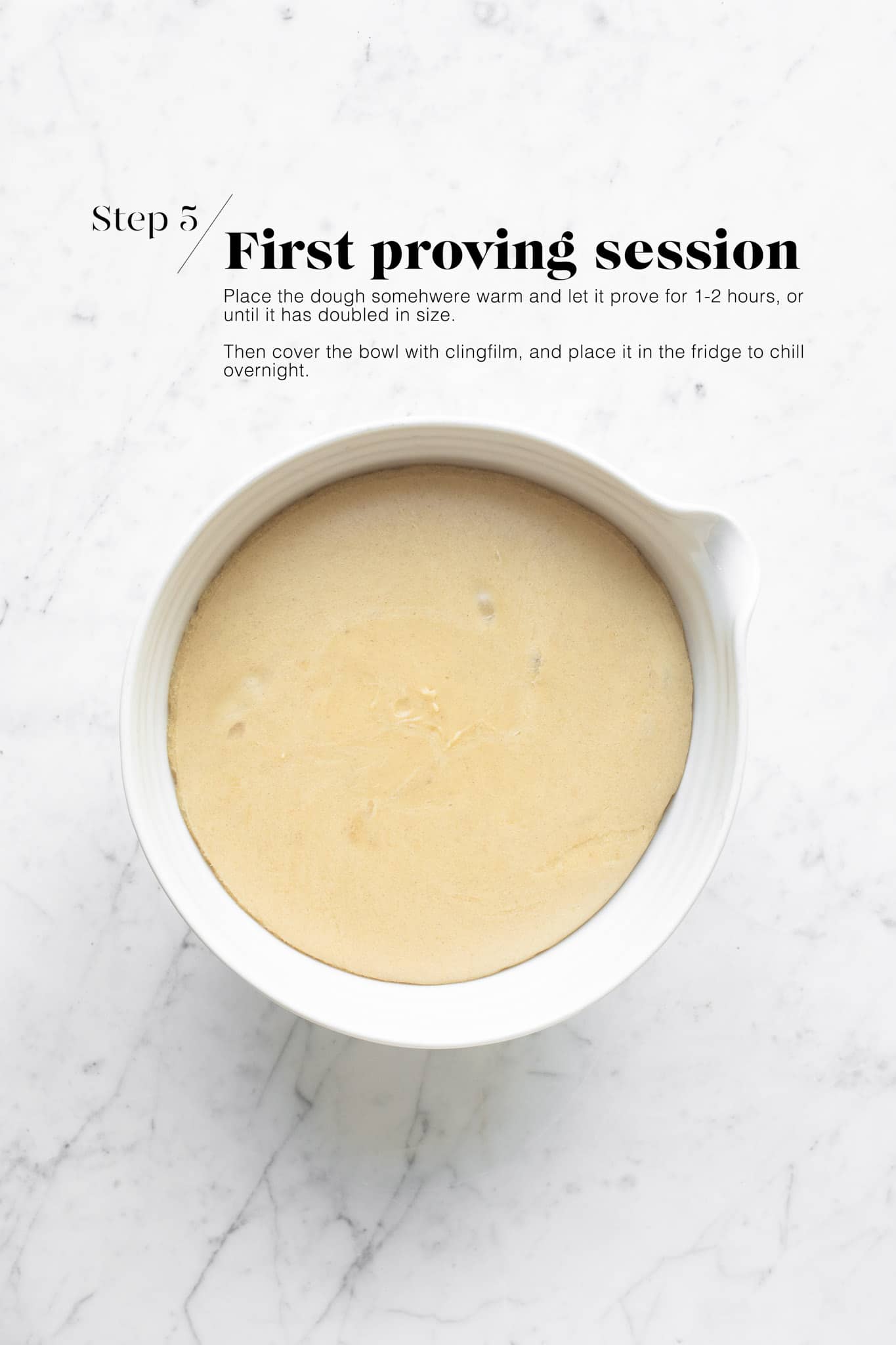
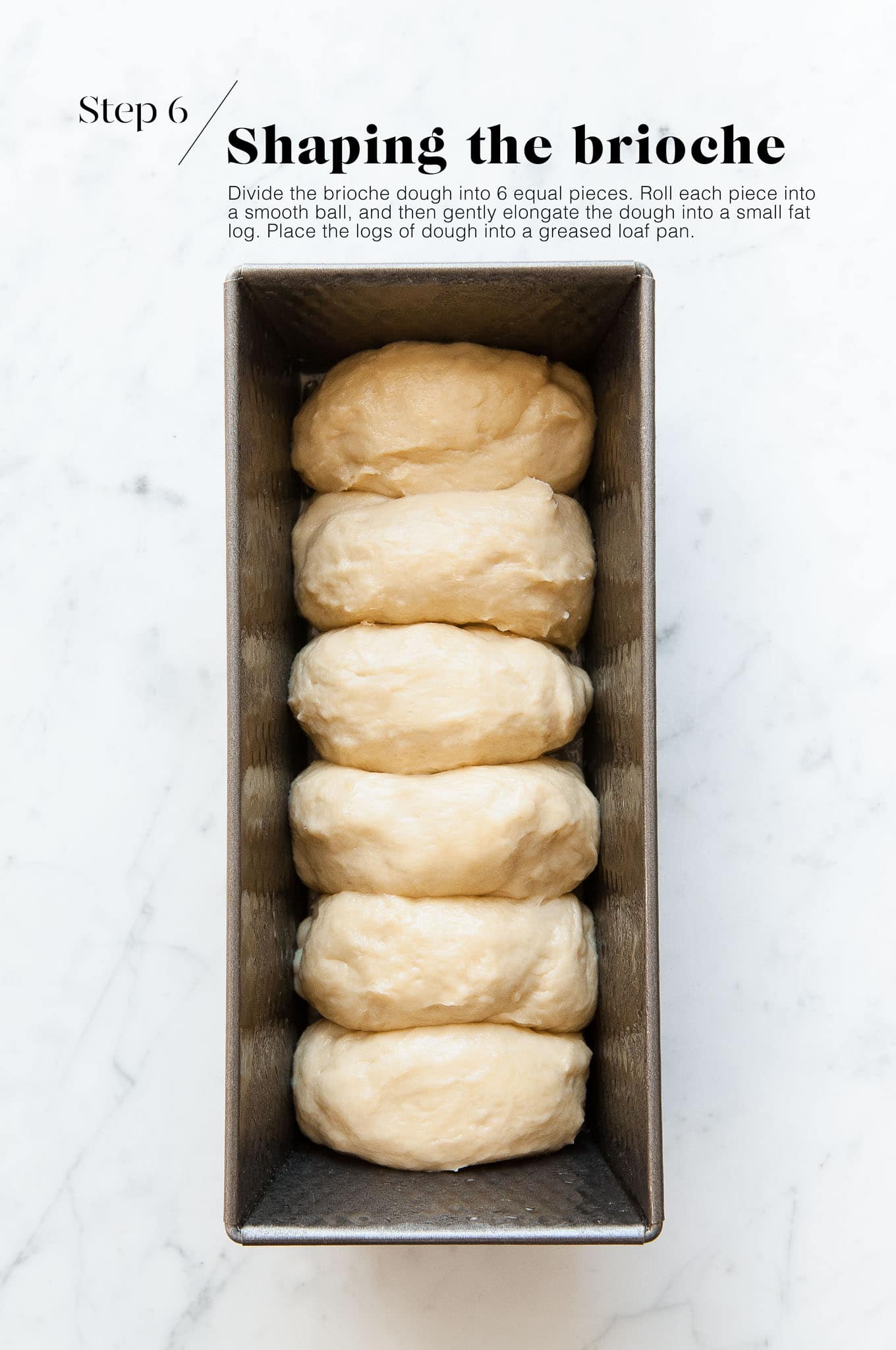
Step 7
Once the brioche dough has doubled in size, brush it gently with some egg wash, and sprinkle generously with pearl sugar.
Bake the brioche loaf for about 30 minutes, or until it has browned nicely all over. I recommend checking at the 10-15 minute mark to make sure that the brioche is not browning too quickly. If so, place a sheet of foil over the brioche, and continue baking for the recommended time.
If you have a digital thermometer, the brioche is cooked if the internal reading is 85°C/185°F.
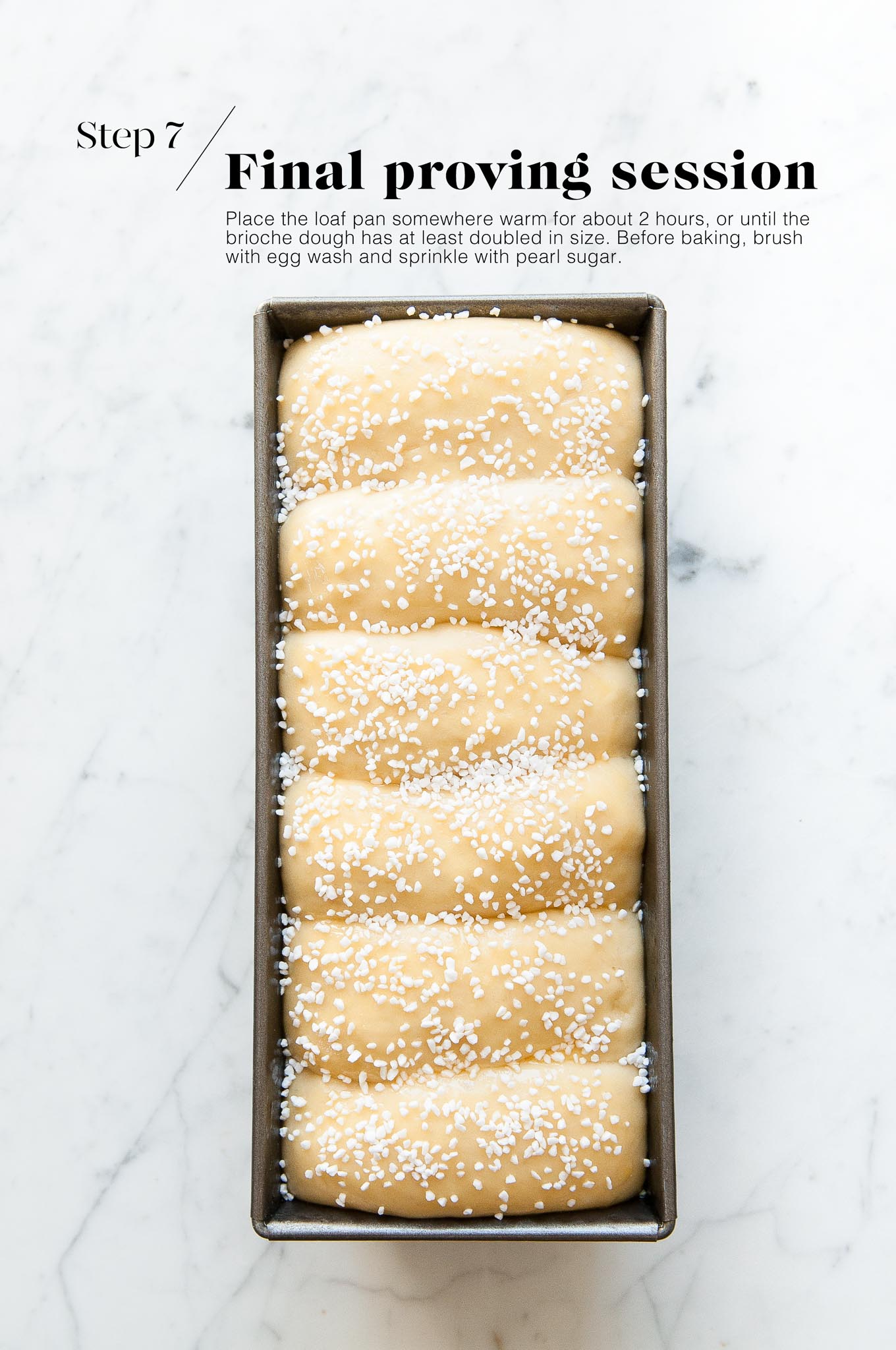
Tips for Making French Brioche
- I recommend using bread flour when making brioche. Bread flour contains more protein, which is necessary to create more gluten. And it is the gluten which helps to give the brioche bread some elasticity, which will result in a nice, chewy texture.
- The brioche dough requires at least 3 sessions of proving to develop flavour, as well as the chewy texture. I like to do one warm session of proving (1-2 hours), one overnight session in the fridge (8-10 hours), and then a final warm session before baking (1-3 hours).
- You could substitute the overnight proving session in the fridge with another warm session of proving, but the texture will not be as optimal (it will still taste great!).
- Brioche loaf is also commonly made as a loaf of buns. Simply follow the instructions as below, but divide the dough into 8 equal pieces and roll them into smooth balls. Place the balls of dough into the loaf pan, so that you have two rows with 4 balls of dough each. Proceed with the rest of the recipe.
How to Proof Dough
Dough needs a warm environment for the yeast to activate and cause the dough to rise. If you don’t have a warm place in your home, try one of the following ideas:
- In the oven with the oven light switched on (works only for some ovens).
- In the oven with a tray of boiling water on the bottom shelf. Use about 1 litre (4 cups) of water, and top up after about 1 hour.
- In the oven at a low temperature of about 25-30°C (77-86°F).
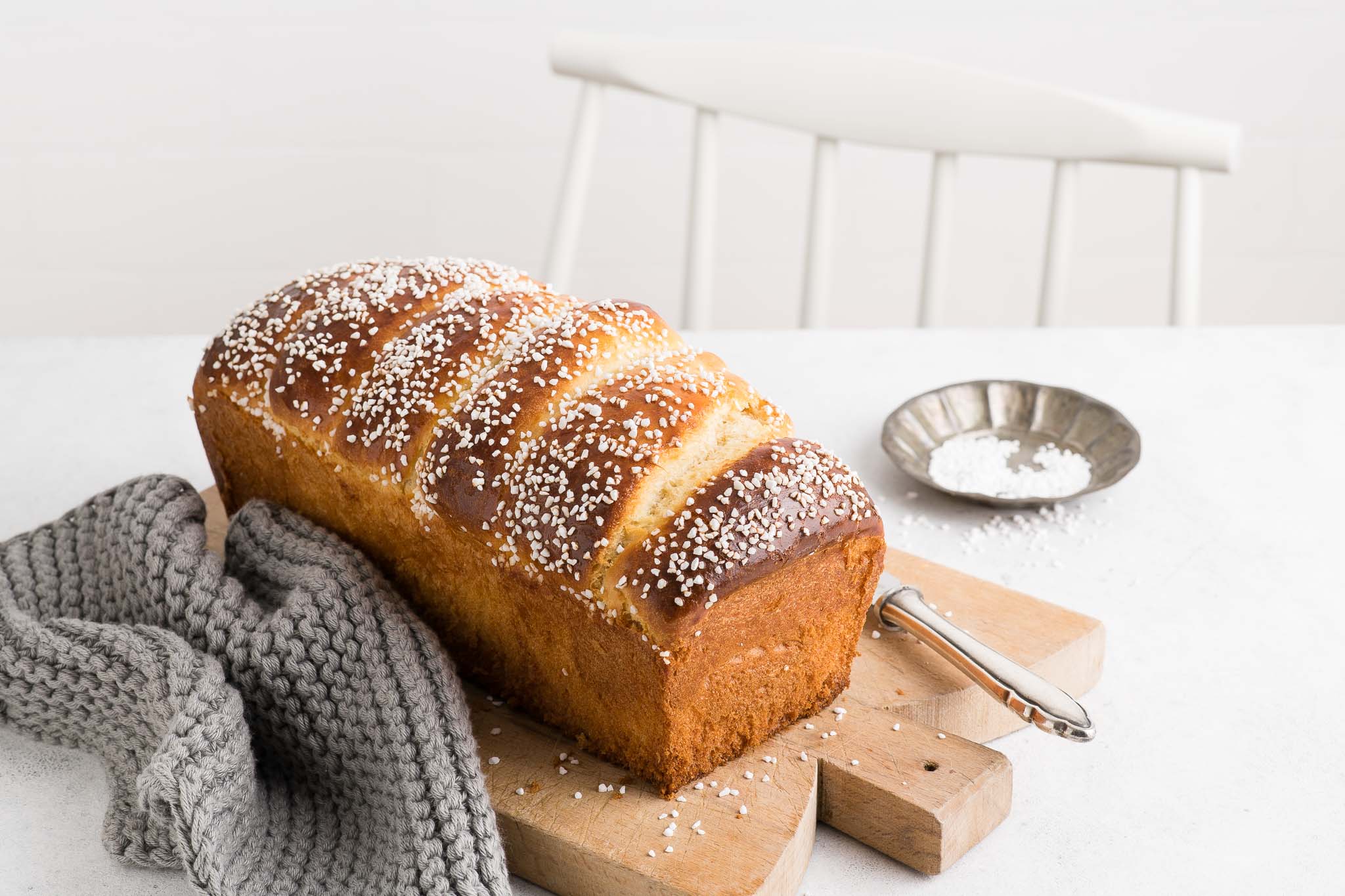
More Bread Recipes
For more bread recipes, you might also like:
PrintFrench Brioche Loaf
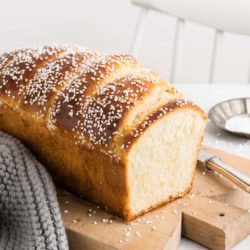
- Resting Time: 2 to 5 hours
- Prep Time: 40 mins
- Cook Time: 30 mins
- Total Time: 1 hour 10 minutes
- Yield: Serves 4 to 6
- Category: Bread
- Method: Oven
- Cuisine: French
A delicious French Brioche Loaf which is soft and buttery. Follow this easy brioche recipe with step-by-step photos.
Ingredients
For the Brioche
- 2 cups (300 g) strong white bread flour (see Kitchen Notes below)
- 1/4 cup (55 g) granulated sugar
- 1/4 oz (7 g) instant yeast (see Kitchen Notes below)
- 1 teaspoon fine salt
- 1/3 cup (90 ml) milk, warmed to blood temperature
- 3 eggs, at room temperature
- 1 stick (100 g) unsalted butter, softened
- pearl sugar, for sprinkling
For the Eggwash
- 1 egg beaten with a dash of milk
Instructions
Begin this recipe the night before.
Day One
- Measure the flour, sugar, yeast and salt in the bowl of an electric stand mixer.
- Attach the dough hook to the stand mixer and lightly mix the dry ingredients together.
- In a small measuring jug, whisk together the milk and eggs.
- Slowly add the milk and egg mixture to the dry ingredients, and keep mixing until a sticky dough forms. The dough should form together loosely around the dough hook. You may need to scrape down the sides of the bowl once or twice to make sure all of the ingredients are well-incorporated. This step should take about 5-10 minutes on medium speed.
- Add a tablespoon of butter and beat until it has been incorporated into the dough. Repeat with the remaining butter, adding one tablespoon at a time.
- Once all of the butter has been added, keep beating for about 10-20 minutes on medium-high speed.
- The dough is ready when it is soft, sticky and elastic in texture, and when it comes away from the sides of the bowl instead of sticking to the sides. I also recommend doing the “windowpane test“, which is to stretch a piece of dough from the dough hook, until it is thin enough that you can almost see through the “window” of dough, and without the dough breaking as you do this test.
- Lightly oil a large bowl. You will need a bowl that is large enough for the dough to at least triple in size.
- Use a dough scraper to scrape the brioche dough into the oiled bowl.
- Place the bowl somewhere warm for the dough to prove for about 1-2 hours, or until the dough has doubled in size.
- Do not touch the dough. Cover the bowl with the risen dough with some clingfilm, and place in the fridge to chill overnight (8 to 10 hours). The dough will continue to rise a bit more in the fridge.
Day Two
- Generously butter a loaf pan (or use a non-stick baking spray). I use a loaf pan which is 25 x 10.5 cm/10 x 4 inches.
- The dough will have risen more overnight in the fridge.
- Punch down the dough to release the air from the dough.
- Gently knead the dough into a smooth ball.
- Weigh the ball of dough and divide this measurement by 6, so that you can portion the dough into six pieces equally. You can, of course, just eye-ball the measurement.
- Roll each piece of dough into a smooth ball, and then gently elongate the balls of dough into a small fat log.
- Arrange the six logs of dough into the loaf pan.
- Place the loaf pan somewhere warm for the dough to rise and at least double in size. This should take 1-3 hours. I generally aim for the edges of the brioche dough to rise to about 1-2 cm (1 inch) below the rim of the pan. Once you bake the brioche, it will continue to rise a lot more.
- Preheat the oven to 200°C (390°F).
- Place a metal baking sheet in the oven.
- Gently brush the top of the brioche loaf with the eggwash.
- Sprinkle the brioche loaf with pearl sugar.
- Place the loaf pan on the metal baking sheet (which has been preheating in the oven).
- Bake the brioche loaf for 30-35 minutes, or until it is lightly golden. You might want to check your brioche at about 10-15 minutes to make sure it is not browning too quickly. If so, place a sheet of foil over the brioche to stop it from browning further.
- If you have a digital thermometer, the brioche is cooked if the internal reading is 85°C/185°F.
- Remove the brioche loaf from the oven and let it settle in the pan for about 5-10 minutes before unmoulding.
- Let the brioche cool completely on a wire rack before serving.
- I recommend using a serrated knife to slice the brioche.
Kitchen Notes
 CAKE PAN SIZE
CAKE PAN SIZE
I use a loaf pan which is 25 x 10.5 cm/10 x 4 inches.
 DIFFERENT TYPES OF FLOUR
DIFFERENT TYPES OF FLOUR
* I recommend using bread flour when making brioche or other types of enriched dough. Bread flour contains more protein than plain flour (all-purpose flour), so look for flour which has 11-13% protein content.
* For Swiss readers, I use Zopfmehl (or farine pour tresse) when making bread and brioche.
 DIFFERENT TYPES OF YEAST
DIFFERENT TYPES OF YEAST
* Please note that there is a difference between instant yeast (also called instant dried yeast or fast-action dried yeast) and dried yeast (also called active dry yeast). If you are not sure what type of yeast you have, please check the packaging for instructions on how to use the yeast.
* With instant yeast, you can add it directly to the flour mixture without having to activate it first.
* With dried yeast, you will need to activate it first (usually in some warm liquid).
 PROOFING THE DOUGH
PROOFING THE DOUGH
Dough needs a warm environment for the yeast to activate and cause the dough to rise. If you don’t have a warm place in your home, try one of the following ideas:
* In the oven with the oven light switched on (works only for some ovens).
* In the oven with a tray of boiling water on the bottom shelf.
* In the oven at a low temperature of about 25-30°C (77-86°F).
 ELECTRIC STAND MIXER
ELECTRIC STAND MIXER
Given the high butter content, it is easiest to make this brioche using an electric stand mixer or a food processor fitted with a dough hook. However, you can, of course, make the dough by hand if you don’t mind a bit of an upper-body workout.
 OVEN TEMPERATURES
OVEN TEMPERATURES
All recipes on this website state temperatures for a regular oven (i.e. a conventional oven without fan). If you have a convection oven with a fan, please consult the manufacturer’s handbook on how to adjust the temperature and baking time accordingly.
 CONVERSIONS
CONVERSIONS
To convert from cups to grams, and vice-versa, please see this handy Conversion Chart for Basic Ingredients.
Update
This recipe was first published on 2 April 2020. It has been updated with new photos and more comprehensive recipe notes.
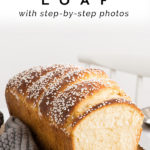
 Print
Print Pin Recipe
Pin Recipe Rate
Rate

Fantastic recipe! This recipe uses less eggs and butter than other recipes I have seen, but the taste is delicious. 10/10!!
Thank you for the helpful photos. The brioche tasted perfect.
Hi Thanh, I will be proofing the dough longer than 8-10 hours in the fridge because of my lack of calculations on the time. Will that be a problem? I love all your recipes. thank you
Hi Nancy,
I sent you an email the other night to respond quickly 🙂 It should be fine if you leave the dough in the fridge for longer than 8-10 hours. But just make sure you use a big enough bowl as the dough will continue to rise, although very slowly, while it is in the fridge. Hope you will enjoy this recipe!
This recipe is delicious and easy to follow.
I did end up leaving it longer in the fridge and it came out great!!
Thanks so much for the fast response!!
Hi Nancy,
That’s so great to hear! So glad you enjoyed this brioche recipe. I love to make it on the weekends 🙂
Excellent recipe. Very easy to follow and the brioche was the best I have ever tasted. Thank you.
Just made this brioche loaf for brunch tomorrow but I’m not sure I can wait that long to eat it! It turned out perfectly, although a bit too brown on top. I should have covered it with foil a bit earlier but I’m sure it will taste great. It certainly smells beautiful!
Great instructions and easy to follow recipe. I’ve made this brioche loaf twice this week and it looks perfect each time. It tastes great and even keeps well for several days.
Delicious recipe. The brioche had a great texture. Thanks for the tips.
My brioche turned out great! The texture was so light and buttery, it tasted absolutely delicious! i can’t wait to make this again soon!
Fantastic recipe. Easy to follow and great tips. I couldn’t find pearl sugar but my brioche loaf still turned out great. The texture was just beautiful.
This is the best brioche I have ever tasted. I was amazed by how soft the dough was and how delicious it tasted. Fantastic recipe and instructions.
Very lovely recipe. The brioche turned out beautifully and tasted wonderful. Great recipe with great instructions.
This is an amazing brioche recipe. Looks beautiful and tastes beautiful.
The most perfect brioche! Very delicious recipe
Beautiful brioche recipe! Your step by step photos were very helpful for a sometimes baker like me.
This is definitely the best brioche recipe ever. Excellent instructions and my brioche came out looking just like in a French bakery!
Wow! I absolutely love this recipe and can’t wait to make it again and try out different shapes. The texture of the brioche was soft and pull-apart tender, and the taste was very nice and buttery. I was so impressed by how good it tasted!
I followed your recipe and techniques and my brioche was just the best ever! I made it for brunch and there was not a crumb left. Everyone loved it!
I love the detail of all of your recipes and this one is no exception. My brioche loaf was so impressive looking and it tasted just divine. Thank you for this recipe!
Ok you definitely need an electric stand mixer to make this dough, and the recipe does take a long time. But the work is so worth it! This brioche loaf is just amazing!
Amazing! I used to not be very confident baking with yeast, but I have tried several of your baking recipes and you make everything look so easy, thanks to your great photos and instructions. This brioche is no exception. So delicious!!!
Thank you for this recipe. I made it the other day and my French husband really loved it.
I love all of your bread recipes and this one is just perfect. The brioche tasted absolutely delicious and the texture was divine. I really love this recipe!
Hands down the best brioche recipe! I browsed lots of recipes before trying yours, mostly because you live in Europe so you probably know a thing or two about brioche. And also because your step by step photos and instructions are so clear and helpful! My brioche was just perfect and it was the best thing I had tasted in a long time!
Wow, this recipe is amazing! I’ve tried making brioche before but this recipe is by far the best I have come across. I realize now that I used to not knead the dough for long enough. I kneaded the dough using the stand mixer for 20 minutes and the texture was just out of this world. I highly recommend this recipe!